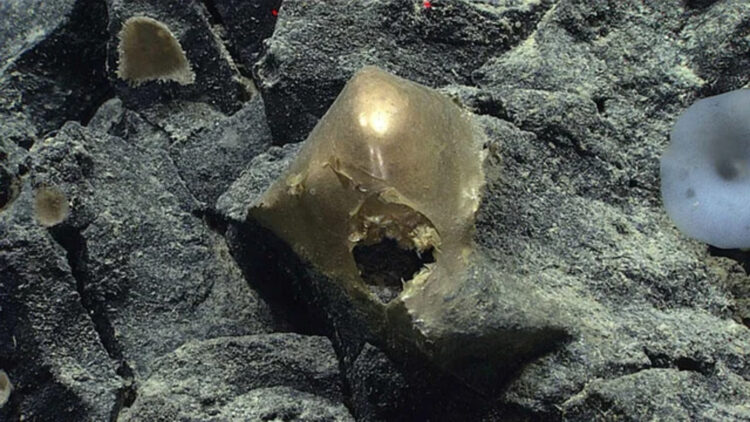As much as humanity has mapped every square inch of our planet Earth, the ocean floor remains largely unexplored. In August 2023, the US National Oceanic and Atmospheric Administration stumbled upon an unexpected mystery during a routine dive. They were in the dark waters of the Gulf of Alaska, at a depth of no less than 3,300 metres, when they came across a shiny sphere that caught the attention of the entire exploration team. This fossil, quickly christened ‘the golden egg’, sparked a wave of global speculation that has yet to be fully resolved.
At the bottom of the Alaskan sea
The Seascape Alaska 5 expedition (EX2306) was quietly mapping and collecting data on the deep-sea habitats of the Gulf of Alaska. Obviously, there were no crew members on board, but rather a remotely operated vehicle that transmitted live images to scientists. Something extremely strange appeared on the screen: a spherical object, approximately 10 cm wide, firmly attached to a rock. In the artificial light of the vehicle, the sphere gave off a metallic glow that baffled all the researchers.
For a scientist who has spent years, even decades, memorising every detail of the habitat where they are working, it is crazy to then have to admit that you do not know what you are looking at. Before detaching it to take it to the surface, they had their doubts, since everyone on the research team had seen the film Alien and knew that it did not end well. However, I prefer not to risk the entire human race by bringing this golden egg to the surface for further analysis.
The golden egg and its mysterious background
Contrary to what might have been thought at first, this golden object was of biological origin. Its texture was smooth, fleshy and skin-like (which ruled out the possibility of it being a geological or mineral structure). What most intrigued researchers was that the sphere, apart from being obviously round, had a kind of hole or tear at its base. This suggested two possibilities: either a predatory creature had entered to eat the egg, or a creature had hatched and emerged from the sphere. (Honestly, we don’t know which option gives us more apprehension.)
To date, the object does not resemble any known egg capsule of any species residing in the deep sea. Other theories suggest that it could be the remnant of a sponge or coral, but scientists are still unclear.
How did they manage to retrieve that golden egg?
At a depth of 3,300 metres, any aerosol could have destroyed the fragile sample. The pilots of the Deep Discoverer ROV, aboard the NOAA Okeanos Explorer ship on the surface, first used the robotic arm to gently push the sphere. (Yes, they poked it with a stick… just with a million-dollar-worth of scientific equipment stick!) This confirmed that it was soft in nature and that a non-destructive extraction technique was needed.
To collect it, they used a Suction Sampler. This device uses negative pressure to gently suck the object into a secure container. This tool is mainly used to preserve the integrity of biological specimens. Once the golden egg was brought to the surface, it was catalogued and photographed. Out of the water, its actual colour turned out to be a more opaque brown or yellow, like ochre. Although it has been catalogued and DNA analysis has been carried out, the DNA has not yet matched any recorded species, which indicates that the vast majority of life in the deep sea remains undiscovered –or at least, genetically sequenced.
Therefore, it is plausible that this golden egg is the first evidence of a totally unknown species inhabiting the seabed of Alaska. If you have a phobia for the deep sea, Alaskan remote landscapes and giant octopuses, and this article may not let you sleep peacefully tonight. However, we are sure that the writer Lovecraft would be delighted to know that there is an underwater species in the depths of the planet that lays giant eggs measuring more than 10 cm.

